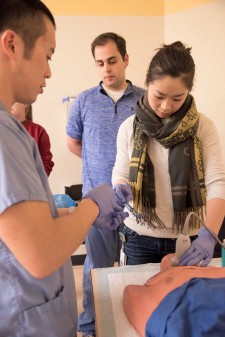Washington University School of Medicine employs simulation for all levels of students in a variety of settings, optimizing the technology and the techniques for the task and the learners. Medical students in all four years learn to diagnose and treat conditions from the common to the rare and life-threatening.

Simulation includes:
- Human “standardized patients” who play realistic roles
- Sophisticated digital tools
- Computer-driven mannequins with life-like fidelity
The simulation centers provide:
- Digital recording of training sessions
- Immediate review and debriefing by an instructor
- Training on a wider variety of diagnoses than in real life
- Immersive team training to ensure effective interaction
- Stress alleviation during the transition from trainee to practicing physician
- No risk to actual patients
The Mannequin Simulators
Mannequin Simulators look, sound and behave so much like real patients, accurately recreating human physiology, that students quickly suspend their disbelief and become immersed in the experience of providing care. On our programmable mannequins:
- First-year students explore human physiology
- Second-year students practice physical examination skills
- Third-year students learn airway management and cardiac resuscitation technique
- Seniors preparing for graduate medical education are evaluated on the mannequins, as they manage a set of eight scenarios that require rapid diagnosis and acute intervention
Visit the website of the Simulation Centers at Washington University School of Medicine to learn more.